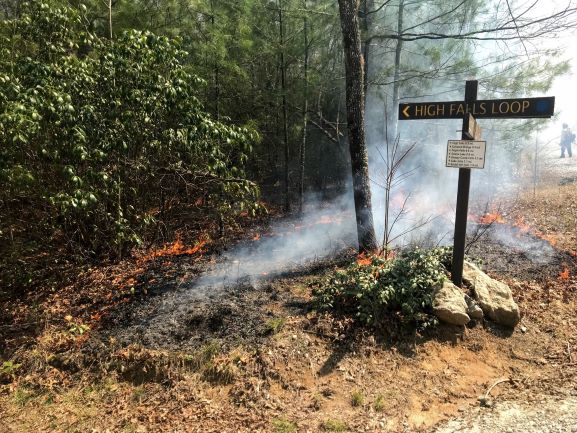Learning About Burning in the North Carolina Mountains
By Dakota Wagner, Southeast Region Coordinator, Forest Stewards Guild
Fire is an important part of the natural environment in the Southern Appalachian Mountains. Native American communities and early settlers utilized fire in their daily lives to promote conditions suitable for hunting and foraging, and to reduce pest populations such as ticks. This use of fire shaped the landscape, and many of the forests in North Carolina today still require fire to remain healthy.

However, fire suppression that began in the early 1900s has led to changes in forest composition. Fire-adapted species that need fire to thrive were, and currently are, being pushed out by non-fire adapted species, in some cases decreasing the species richness and diversity of the forest. Large strides have been made to bring fire back onto the landscape in the mountains of North Carolina and restore these spectacular ecosystems.
In the spring 2021 burn season, prescribed fire operations reached record highs due to personnel availability and ideal weather conditions. In fact, The Nature Conservancy’s as-needed Southern Blue Ridge Burn Crew assisted or led the implementation of 42 prescribed burns across more than 18,000 acres in the mountains of North Carolina, a record-breaking year! Most of these burns were on public land. To continue making significant strides in forest restoration, practitioners throughout the region want to see more burning on privately owned lands. Why? Forestland ownership in North Carolina is dominated by nonindustrial private landowners, who own a staggering 80 percent of the total forested acreage of the state.
Family forest landowners often have forest ownership goals that include maintaining and enhancing the forest in a natural, healthy way. To meet those goals in certain forests in the mountains of North Carolina, fire is necessary. That being said, there are many landowners today who may not be familiar with the benefits of prescribed fire, nor may they have the tools to implement these practices on their properties.
This brings us to our main event, “Learning About Burning: An Introduction to Prescribed Fire for NC Landowners.” With support from the Fire Learning Network, the Forest Stewards Guild collaborated with NC Forest Service, Mountain Valleys RC&D Council, and NC Wildlife Resources Commission to produce a virtual experience based at DuPont State Recreational Forest near Brevard, North Carolina. In this video, questions such as “What is the difference between a prescribed burn and a wildfire?”, “Why should we burn?”, and “Can I burn my own property, and if so, what do I need in order to do that safely?” are answered by a variety of experts during a live burn.
This virtual experience is one of the many steppingstones that landowners can take to learn about burning to reach their forest restoration goals. Practitioners and other landowner outreach agents can use this video when communicating with both landowners and the public about the basics of prescribed fire in the mountains of North Carolina.
Want to take the next step and learn more?
- How to become a NC certified burner https://www.ncforestservice.gov/fire_control/fc_howtobeacertifiedburner.htm
- NC Prescribed Fire Council http://ncprescribedfirecouncil.org/
Not in North Carolina? Find your Prescribed Fire Council or contact your state forestry agency.
Contact Dakota Wagner: dakota@forestguild.org, 828-771-6256